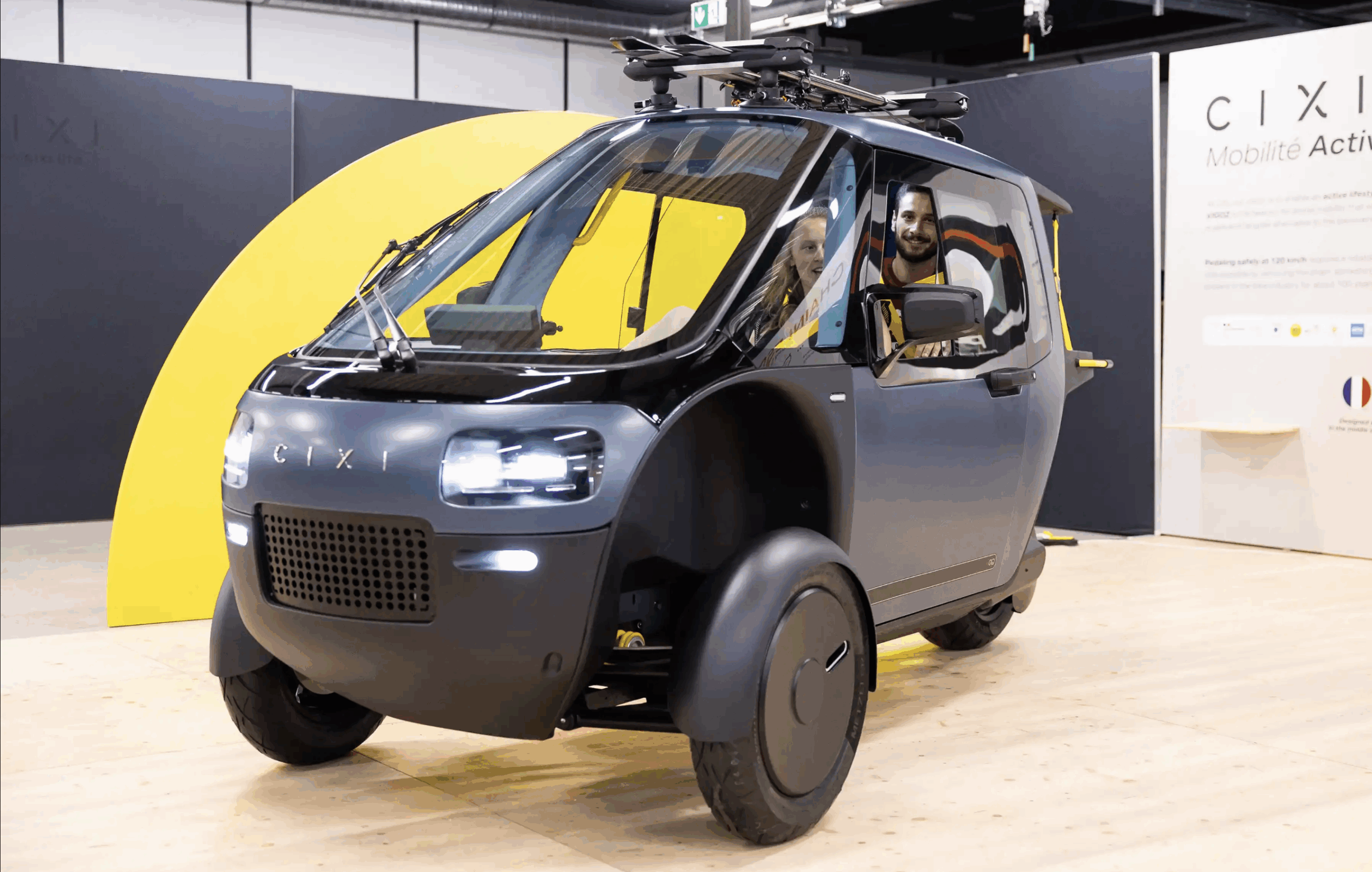The VIGOZ is a striking attempt to reinvent what personal transportation can be. Created by the French company CIXI, this “active vehicle” aims to bridge the gap between a bicycle and a car — letting people move fast, comfortably, and safely, while still engaging their bodies in the process.
CIXI describes the VIGOZ as a machine built for the way we should move — actively, efficiently, and sustainably. Instead of sitting passively in traffic, drivers become riders again, generating part of the vehicle’s energy through a new chainless pedaling system called PERS.
At its core, the VIGOZ isn’t just a machine, it’s also a philosophy. CIXI believes modern transportation has made us too passive, and that we’ve lost something vital in the process. The VIGOZ is designed to restore that connection, turning daily commutes into light physical activity without forcing riders to sacrifice comfort or time.
Pierre Francis, CIXI’s founder, envisioned a vehicle that combines the joy and engagement of cycling with the protection and convenience of a car. The result is something that can keep up with traffic, shield its passengers from the weather, and still make them feel like they’re participating in their own motion. Every aspect of the VIGOZ’s development reflects this “active mobility” mindset, from its sleek, aerodynamic body to its intelligent pedaling interface that adjusts to the user’s preferred effort level.
The VIGOZ is designed and assembled in Haute-Savoie, France, near the city of Annecy. CIXI’s facility in Poisy serves as both its research hub and its production site. The company highlights the importance of local craftsmanship, regional expertise, and sustainability — not just in the materials it uses, but in how the entire lifecycle of the vehicle is managed.
The goal is longevity: a 15-year life cycle, with replaceable body panels, repairable components, and software updates that keep the VIGOZ relevant over time. Instead of throwing vehicles away, CIXI wants them to evolve with their users.
At the heart of the VIGOZ is the PERS system, short for Pedaling Energy Recovery System. Unlike a bicycle, there’s no mechanical chain or belt. Instead, the rider’s pedaling is sensed electronically and translated into propulsion.
The pedals are more than just fitness tools — they’re control inputs. Pedaling forward accelerates the vehicle, and pedaling backward helps it slow down and even regenerate energy. Because there are no gears, the experience is smooth and continuous. Riders can set how much effort they want to contribute, from a gentle assist to a challenging workout, while the system intelligently balances power between human input and electric drive. This setup not only engages the rider but also helps extend range, making the VIGOZ more efficient than a fully electric car of comparable size.
Despite being human-powered in part, the VIGOZ is built for real-world travel, including highways. CIXI claims a top speed of 120 km/h (about 75 mph) and an effective range of 160 km on a full charge.
The battery, rated at 22 kWh, can recharge in roughly six hours using a standard 220 V household outlet. Regenerative braking, coupled with energy input from pedaling, helps recover power during travel.
At 165 cm tall, the vehicle is designed for road visibility and safety, while an active tilting system keeps it stable in corners and at speed. The result is something that feels agile like a bike but grounded like a car.
Although its technology is futuristic, the VIGOZ is meant to handle everyday life. Its extendable rear trunk can carry luggage, groceries, or sports equipment, and it’s IsoFix-compatible, meaning a child seat can be safely installed.
The cabin is enclosed and weather-protected, featuring sliding windows and a full HVAC system for comfort in all seasons. CIXI emphasizes ergonomics — controls are easy to reach, and visibility is optimized for drivers of different heights. The VIGOZ also includes connectivity tools for sharing, fleet management, and over-the-air updates. For adventure-minded users, optional accessories like ski mounts expand what the vehicle can do.
CIXI has outlined a multi-stage roadmap for bringing the VIGOZ from concept to production:
Testing has taken place in the French Alps, where steep climbs, curving roads, and long distances help CIXI evaluate performance under demanding conditions.
A post shared by CIXI Active Mobility (@cixilife)
CIXI isn’t planning to sell the VIGOZ in the traditional way. Instead, it proposes a subscription model, letting users access the vehicle without long-term commitments. Subscribers can return it anytime and even earn loyalty rewards, such as a 1% discount for every year of continued membership. This approach supports flexibility, reduces the barrier to entry, and fits with CIXI’s idea of shared, sustainable mobility. Fleet managers and communities could also deploy groups of VIGOZ vehicles for shared use.
While the VIGOZ’s concept is bold, it faces significant hurdles before it can transform mobility at scale. Gaining regulatory approval for highway use is a complex process that involves safety, classification, and crash-testing standards. Manufacturing complexity is another challenge: integrating a high-capacity battery, active tilting, and chainless pedaling in a lightweight body requires precise engineering. Costs and subscription pricing have not yet been made public, and user adoption will depend on affordability as much as innovation.
There are also questions about how the pedaling experience feels at high speed — whether it’s intuitive, safe, and rewarding, or simply novel. But CIXI appears confident that their testing and design iterations will refine those details.
The VIGOZ doesn’t fit neatly into existing categories. It’s not exactly a car, not exactly a motorcycle, and not exactly a bicycle. Instead, it’s trying to define a new space — a human-electric hybrid vehicle designed for daily life. If successful, it could appeal to commuters who live too far to cycle but still want to stay active, as well as sustainability-minded users who want the efficiency of a small electric vehicle without the passivity of driving one. CIXI’s vision reaches beyond a single product. It’s about rethinking what mobility can be — active, personal, and environmentally responsible.
As of now, the VIGOZ is moving toward road certification and small-scale production. CIXI encourages interested users to sign up for updates or join the “VIGOZ Club” to follow its progress. The next few milestones will reveal whether this concept can transition from innovation showcase to real-world product. Certification, pricing, first deliveries, and public reviews will all determine how disruptive this new form of mobility can be. But even in prototype form, the VIGOZ challenges how we think about movement. It suggests a future where cars don’t just move us — they move with us.
CleanTechnica’s Comment Policy
Derek lives in southwestern New Mexico and digs bicycles, simple living, fungi, organic gardening, sustainable lifestyle design, bouldering, and permaculture. He loves fresh roasted chiles, peanut butter on everything, and buckets of coffee.
Derek Markham has 674 posts and counting. See all posts by Derek Markham












